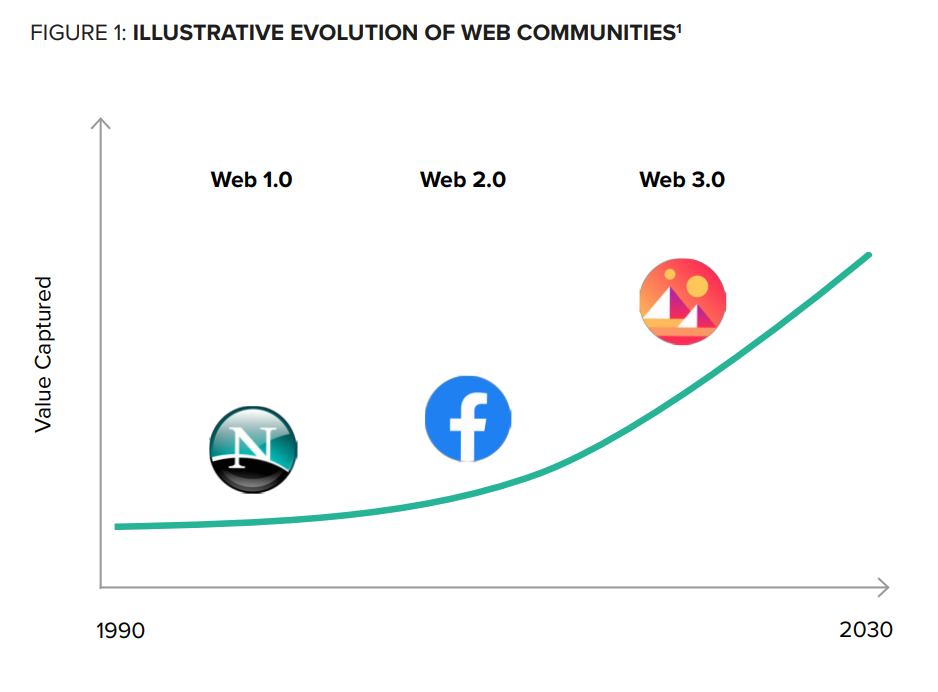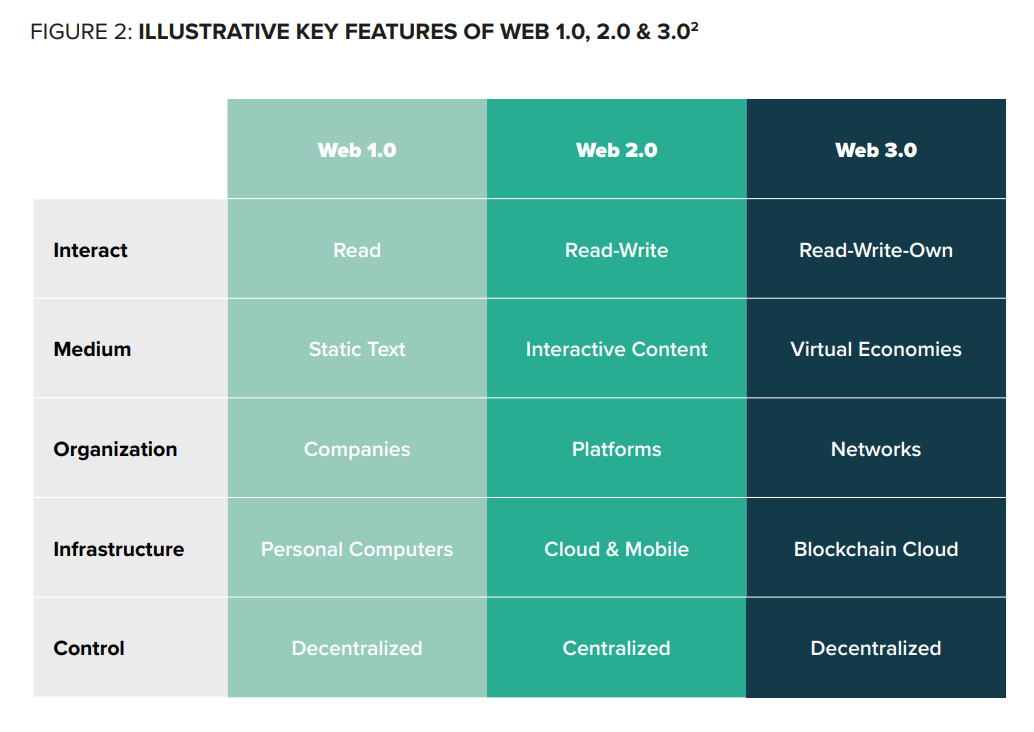25th november 2021 / Anthony cheung
The Metaverse explained
After Facebook renamed itself (perhaps more for optics right now than anything else!) to Meta, it's brought the Metaverse conversation to the main stream.
As we know Facebook have an insane amount of monthly active users. In fact as of Q3 2021 that figure stood at 2.91bln, making it by far the world's largest social network.
Crypto cloud economies are the next emerging market investment frontier and the Metaverse is at the forefront of this Web 3.0 internet evolution.
What is the Metaverse?
The Metaverse is a set of interconnected, experiential, 3D virtual worlds where people located anywhere can socialize in real-time to form a persistent, user-owned, internet economy spanning the digital and physical worlds.
Grayscale Investments LLC break this down into 3 distinct patterns of evolution of web communities.
Web 1.0 - Netscape connected us online
Web 2.0 - Facebook connected us into online communities
Web 3.0 - Decentraland connected us into community-owned virtual world
As we know Facebook have an insane amount of monthly active users. In fact as of Q3 2021 that figure stood at 2.91bln, making it by far the world's largest social network.
Crypto cloud economies are the next emerging market investment frontier and the Metaverse is at the forefront of this Web 3.0 internet evolution.
What is the Metaverse?
The Metaverse is a set of interconnected, experiential, 3D virtual worlds where people located anywhere can socialize in real-time to form a persistent, user-owned, internet economy spanning the digital and physical worlds.
Grayscale Investments LLC break this down into 3 distinct patterns of evolution of web communities.
Web 1.0 - Netscape connected us online
Web 2.0 - Facebook connected us into online communities
Web 3.0 - Decentraland connected us into community-owned virtual world

To take this conceptual idea one layer deeper Grayscale define 5 key features that reflect the evolution from Web 1.0 to 3.0.

Demographics and behaviour matter
Research out of the investment bank Goldman Sachs shows that in today's modern world the average US person spends approx. 8 hours a day watching TV, playing games, or on social media.
The statistic of greatest interest is the breakdown of the demographic. Facebook is more than aware of this as it struggles to keep Gen Z users engaged and is seeing increasing competition from rivals such as Snapchat and TikTok who have seen explosive growth of late.
A new paradigm
A big part of the shift to decentralised finance is also a reflection of the times with Web 2.0 being centrally owned and controlled by big tech against Web 3.0, which is democratically owned and controlled by global users.
The tantalising prospect for the future is this new paradigm allows users to own their digital assets as Non-Fungible Tokens (NFTs), trade them with others in the game, and carry them to other digital experiences, creating an entirely new free-market internet-native economy that can be monetized in the physical world.
The crypto cloud economy
Grayscale does a great job breaking down the ecosystem into a succinct way.
Payment Networks: Web 3.0 metaverse economies can use their own digital currency, like MANA, or the currency of the layer one base crypto cloud economy platform they’re built on, such as Ethereum (ETH) or Solana (SOL).
Research out of the investment bank Goldman Sachs shows that in today's modern world the average US person spends approx. 8 hours a day watching TV, playing games, or on social media.
The statistic of greatest interest is the breakdown of the demographic. Facebook is more than aware of this as it struggles to keep Gen Z users engaged and is seeing increasing competition from rivals such as Snapchat and TikTok who have seen explosive growth of late.
A new paradigm
A big part of the shift to decentralised finance is also a reflection of the times with Web 2.0 being centrally owned and controlled by big tech against Web 3.0, which is democratically owned and controlled by global users.
The tantalising prospect for the future is this new paradigm allows users to own their digital assets as Non-Fungible Tokens (NFTs), trade them with others in the game, and carry them to other digital experiences, creating an entirely new free-market internet-native economy that can be monetized in the physical world.
The crypto cloud economy
Grayscale does a great job breaking down the ecosystem into a succinct way.
Payment Networks: Web 3.0 metaverse economies can use their own digital currency, like MANA, or the currency of the layer one base crypto cloud economy platform they’re built on, such as Ethereum (ETH) or Solana (SOL).
Decentralized Finance: Decentralized exchanges allow users to trade in game items while lending platforms allow users to take out loans on their virtual land.
NFT Sovereign Goods: Players can purchase NFTs from other creators and bring them into other virtual worlds to be put on display or sold.
Decentralized Governance: Legal frameworks take back control of the digital economies from centralized corporations and allow a global network of Web 3.0 metaverse users to decide the rules of their collectively owned virtual space.
Decentralized Cloud: File storage solutions such as Filecoin give Web 3.0 metaverse worlds a decentralized infrastructure solution to store data while services like Livepeer give virtual worlds decentralized video transcoding infrastructure.
Self-Sovereign Identity: Internet-native social reputation coin (“creator coins”) data from other platforms may be transferred into the Metaverse and used for identity or credit scoring.
Find out more on the history and timeline to adoption
Earlier this month I spoke to Matthew Cheung, CEO of fintech firm iPushPull about the Metaverse and Web 3.0. You can watch the full conversation by registering for the hub on the button below.
Further in-depth discussions with industry leaders on decentralised finance and Fintech feature in our Summer Analyst Training Programme.
Further in-depth discussions with industry leaders on decentralised finance and Fintech feature in our Summer Analyst Training Programme.
Access more free content
Useful Links
EMPLOYERS
UNIVERSITIES
Contact
Sign up to our e-newsletter for the latest market news and careers support.
Sign up to our e-newsletter for the latest market news and careers support.
© Amplify Trading LTD (REG NO: 06798566) VAT: GB947568566. Registered England and Wales.
Useful Links
STUDENTS
EMPLOYERS
UNIVERSITIES
Contact
-

Amplify Trading, 18 St Swithlin’s Ln, London EC4N 8AD
-
 +44 (0) 203 372 8415
+44 (0) 203 372 8415
-
 info@amplifyme.com
info@amplifyme.com
Sign up to our e-newsletter for the latest market news and careers support.
© Amplify Trading LTD (REG NO: 06798566) VAT: GB947568566. Registered England and Wales.